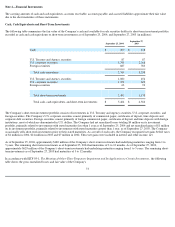Apple 2004 Annual Report Download - page 72
Download and view the complete annual report
Please find page 72 of the 2004 Apple annual report below. You can navigate through the pages in the report by either clicking on the pages listed below, or by using the keyword search tool below to find specific information within the annual report.
losses from these translations were insignificant and have been included in the Company's results of operations.
Revenue Recognition
Net sales consist primarily of revenue from the sale of products (hardware, software, and peripherals), and extended warranty and support
contracts. The Company recognizes revenue pursuant to applicable accounting standards, including Statement of Position (SOP) No. 97-2,
Software Revenue Recognition , as amended, and Securities and Exchange Commission (SEC) Staff Accounting Bulletin (SAB) No. 104,
Revenue Recognition
.
The Company recognizes revenue when persuasive evidence of an arrangement exists, delivery has occurred, the sales price is fixed or
determinable, and collection is probable. Product is considered delivered to the customer once it has been shipped and title and risk of loss have
been transferred. For most of the Company's product sales, these criteria are met at the time the product is shipped. For online sales to
individuals, for some sales to education customers in the U.S., and for certain other sales, the Company defers revenue until the customer
receives the product because the Company legally retains a portion of the risk of loss on these sales during transit. If at the outset of an
arrangement the Company determines the arrangement fee is not, or is presumed to not be, fixed or determinable, revenue is deferred and
subsequently recognized as amounts become due and payable.
Revenue from extended warranty and support contracts is deferred and recognized ratably over the warranty and support periods. These
contracts typically include extended phone support, certain repairs, web-based support resources, diagnostic tools, and extend the Company's
one-year basic limited parts and labor warranty.
The Company sells software and peripheral products obtained from other companies. The Company establishes its own pricing and retains
related inventory risk, is the primary obligor in sales transactions with its customers, and assumes the credit risk for amounts billed to its
customers. Accordingly, the Company recognizes revenue for the sale of products obtained from other companies at the gross amount billed.
Revenue on arrangements that include multiple elements such as hardware, software, and services is allocated to each element based on the
relative fair value of each element, which is generally determined by vendor specific objective evidence (VSOE). Allocated revenue for each
element is recognized when revenue recognition criteria have been met for each element. VSOE is determined based on the price charged when
each element is sold separately.
The Company records reductions to revenue for estimated commitments related to price protection and for customer incentive programs,
including reseller and end user rebates, and other sales programs and volume-based incentives. The estimated cost of these programs is accrued
as a reduction to revenue in the period the Company has sold the product and committed to a plan. The Company also records reductions to
revenue for expected future product returns based on the Company's historical experience.
Generally, the Company does not offer specified or unspecified upgrade rights to its customers in connection with software sales or the sale of
extended warranty and support contracts. However, a limited number of the Company's software products are available with maintenance
agreements that grant customers rights to unspecified future upgrades over the maintenance term on a when and if available basis. Revenue
associated with such maintenance is recognized ratably over the maintenance term.
68
























